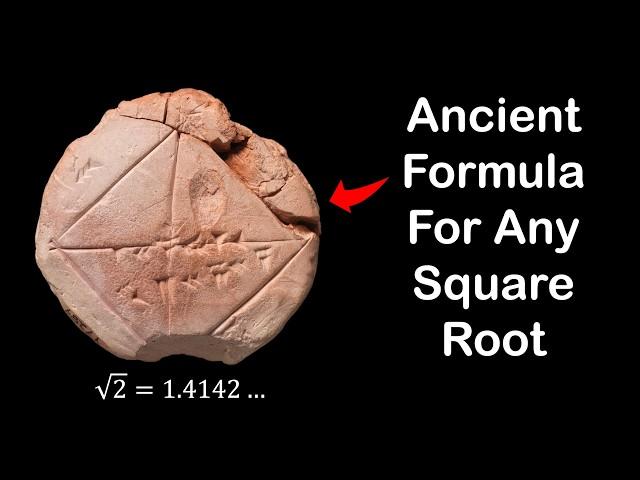Комментарии:

Awesome
Ответить
Why does it look like dragon tongue?😊
Ответить
This all seems creative archeology. You simply fantasize to make the finding fancy.
Ответить
Isnt it similar to the differntiation method of approximations?
Ответить
The Astronaunt Thoth was the Science Officer of Mathmatics and the Calendar. So no suprize here.
Ответить
111 is not closest to 100, it is closest to 121.
Ответить
I’m going to teach my kid this. What a great way to use square roots and such a simple method.
Ответить
Thx. very smart Anticers.Respect😅
Ответить
Very cool!
Ответить
Clearly this was base 10. They just didn't care to go beyond 60 due to the difficulty of stacking the 10's symbol.
Ответить
The wildest algorithm I've seen calculates it digit by digit in a method that looks a lot like long division. The biggest problem there though is that with each calculated digit, the length of the residual numbers increases, making the math more and more impractical.
Ответить
Its like a vedic mathematics!! Mesopotamian civilization, Is it in present day Iraq?? If so can any civilization develop there geographically?
Ответить
C’mon man. Everyone knows the square root of 69 is 8-something
Ответить
it is the same algorithm we use to calculate sqrt , but displayef in other way
Ответить
For 111 you should've had 121 11×11 on your list instead of using 100 10×10
Ответить
My dad taught me the fast way to calculate the diagonal by multiplying aside by square root of two that was a very fun lesson.
Ответить
Fun fact, how you measure length across a 45 degree angle is L+Hx1.414
Ответить
Btw these things are for sure related, but i wanted to mention that -b/2a is also used in the quadratic formula to solve equations of the type ax²+bx+c=0
Ответить
I'm convinced people of ancient times were vastly smarter than people today. Even people 100 years ago were much smarter. Each generation is losing a significant level of intelligence.
Ответить
There is just something about that
4 7 😍

Ahh, a method other than doing it visually in my head. incidentally very similar to this come to think about it. this is way more rapid.
thank you.

Cuneiform/chicken scratch has not been properly translated if it can even be considered to be translated. And today's people give the Babylonians too much credit for this chicken scratch. If the Greeks had not come around and then lighten the world you would not be here today supposedly deciphering mathematical chicken scratch based on your modern knowledge derived from the Greeks. Diodorus the Sicilian an ancient man describe the Babylonians does kindergarten kids in comparison to the Greeks with regards to their knowledge on anything.
But you are a great math teacher and I love your videos

The ancients were smart cz they didn’t have Social Media! Besides, we got calculators right! 😂
Ответить
The formula at the start based on the inscriptions showed denominators raised to the power of 1, 2 and 3 respectively but your explanation did otherwise. Also it’s is not clear how you go from the inscription to your visual representation. Does your method for base 10 also work for base 60. The base 10 calculation must be more involved for computers that work in binary and the circuits either add or subtract numbers. They are much more steps than the base 10 method Bute the processor speed makes up for that.
Ответить
Using this method, what is the square root of -1?
Ответить
As a mirror to this technique, there is the fast inverse square root technique (wikipedia, "Fast_inverse_square_root") that has been equally useful. @MindYourDecisions - please consider making a video about this technique!
Ответить
Amazing god like transcendence - wow! Easy pisi - thank you but where does the double come from?
Ответить
Vedic Math is more accurate
Ответить
🤯
Ответить
Didn't Babylonians use base 60 math?
Ответить
When you write all this stuff out it's almost two pages for one square root. It makes you appreciate calculators and admire how people did this before calculators.
Ответить
In Calculus, this is called Newton's Method.
Ответить
Hi Presh,
It's a bit late but still. It's a really interesting approach. I tried to write an algorithm by myself some time ago but I used kinda "dichotomy": I searched for the interval of two consecutive integers whose squares are upper and lower bound of the given integer and took their arithmetic mean. If the square of this AM is less then the given integer, I assigned AM to the lower bound, otherwise - to the upper bound. Did as many iteration as needed to get a desired precision level. 🤔

btw the square of 111 is closer to 121 than 100 ... making the equation 11 - 10/22 = 10.545454 ... actual 10.53565
Ответить
Bc not bce
Ответить
I believe I worked out a more accurate method than the one shown in the video using the iterative formula xn+1 = (S - xn²) / (2xn + 1)
Here you iterate as before, with S being the number you need the square root from, and xn+1 being the next approximation after xn.
I compared my formula against the one in the video with several examples, and mine appears to produce more accurate approximations. I also reverse engineered the principle behind the babylonian method and it works like this ...
Take the number that produces the required square when multiplied by the last approximation, then the next approximation is the average between the two.
My solution works differently. I use an observation that the x=y² curve produces almost straight lines between adjacent integers along the x axis, and this observation is translated directly in my formula (the 2xn+1 calculates the change in the y axis between adjacent integers on this curve).
I divide by 2xn + 1 because this finds the point on the straight line graph that corresponds with the point on the curve, and the result is a very close approximation to the required value (and as mentioned earlier, this does seem more accurate than the method you showed.

Blew my mind.
Ответить
Im proud to be a Sumerian/Assyrian/Babylonian.
Ответить
What is rational behind this algorithm ?
Idea here is to calculate an approximation of sq.root of a number that is very near to an square of an integer . Please notice that this method works very well when the difference between the given number and its neighboring square is very small . So ,
If y = x^n
dy/dx = nx^(n--1)
In case of square root ,
y = x^(1/2)
dy/dx = 1/2 x^(1/2 --1 )
= 1/2x^(--1/2)
1
= ----------------------
2 x^1/2
And this is the Mesopotamian method to calculate approximate value of square root .
If the difference between the given number and its neighboring square is VERY VERY SMALL , very accurate value can be obtained .

While it is interesting, was zero invented during Babaylalion era . If not 10 was not available except in roman numerals
Ответить
I will need to watch this again, but find it fascinating.
Ответить
How about coming up with a square root solution that’s correct to three decimal places
Ответить
Babylons know about the 365 if they studied middle patterns
Ответить



![[HOONIGAN] Ken Block's GYMKHANA NINE: Raw Industrial Playground [HOONIGAN] Ken Block's GYMKHANA NINE: Raw Industrial Playground](https://invideo.cc/img/upload/VThnWmtWNVhrYl8.jpg)



![Wedding: Velox 2019 [Ugoo & Ogoo] Wedding: Velox 2019 [Ugoo & Ogoo]](https://invideo.cc/img/upload/STU0WGFjdDVVZFY.jpg)


















